Methamphetamine is one of the most dangerous drugs that an individual can take. It kills hundreds of people every year and can be deadly both in preparation and consumption. Users of Meth put their physical and mental health at risk and are often violent and belligerent to their loved ones. One of the most visual markers of this debilitating addiction is
What is Meth?
Methamphetamine is a drug in the amphetamine class of drugs. It is a highly synthesized stimulant that is often produced from the combination of a number of other drugs. These drugs are based in a compound that has been known to scientists for over one hundred years. Synthesis helps lead to an impure product that is often dangerous and can be diluted with even more dangerous substances.

The drug has not been completely banned from every possible legitimate use such as other drugs like LSD and PCP. In fact, Meth has some chemical properties that are helpful in a clinical setting such as vasoconstriction and increased concentration. It can sometimes be helpful in a diluted form for people suffering from ADHD and other attention-related disorders. But its highly addictive components make it dangerous in almost all circumstances.
Effects of Meth
Meth use is associated with a number of health problems and side effects. The clearest reason that users take the drug is for its stimulant effects. Users report a massive increase in energy and an exaggerated high. This high lasts for a brief period of time and leads to an elevated mood, less feelings of depression, and lower anxiety levels. The effects are similar to those who take other forms of stimulants such as amphetamines and cocaine. Another specific benefit to users is that of an aphrodisiac. Users of Meth report heightened sexual performance as well as energy and mood.
But over time, the effects of drug abuse begin to show. People become irritable and angry. They suffer from psychoses as the dopamine pathways in their brains begin to break down. Eventually, the drug begins to rewire their brain to where they only feel any sort of satisfaction or peace when they are taking it. The drug is a neurotoxin and destroys many of the chemical pathways that bring pleasure and regulate emotions for people involved.
The withdrawal effects of Meth are some of the worst of any drug. People who are withdrawing from Meth often have severe reactions such as nausea, hallucinations, and extreme depression. While there are no direct medications that help with withdrawal, there are a wide variety of antipsychotic and antidepressant medications that former users can take in order to ween themselves off of the drug.
Meth and drug-induced hair loss
The clearest sign of Meth usage to other people is the set of physical changes that it causes to users. Meth weakens many of the non-permanent attributes that are on every person. The most common example of this is the teeth. When on meth, people’s teeth grow weaker and they can have cavities and turn black. There is no scientific consensus as to exactly why this happens, although a major theory is that people on Meth live such unhealthy lifestyles that these changes are due entirely to the modified behavior associated with Meth usage.

Many people on Meth lose their teeth and are forced to chew food and live their lives with constant dental pain. These same factors all affect the hair and hair follicles as well. People on Meth often lose much or all of their hair. The hair that remains is weak, matted, and prone to breakage. Like with teeth, there is still some uncertainty as to whether the meth breaks down the hair or causes a person to live so poorly that their diet (malnutrition) and behavior results in hair loss or even diffuse alopecia. No matter the explanation, it is a visible symbol of the general breakdown that is happening in a person’s body as they continue to poison it with meth.
Recovery
Meth is one of the most difficult drugs to enter into recovery from. There is no proven cure or medication-based treatment. The drug does immense damage to neural pathways and the parts of the brain that deal with understanding and processing emotions. Rebuilding these pathways is the first step to recovery and can be a years-long process. Meth also has a considerable amount of stigma attached to it and fewer support systems available for those affected by the drug. In addition, recovered addicts groups are often small because the drug is so difficult to get away from.
Anyone who currently faces a Meth addiction needs to stop using immediately. They need to stop and begin the healing process from this dangerous drug as quickly as possible. Then, anyone with this drug addiction needs to find a supportive base. They should reach out to family, friends, and other former addicts who can help them come up with alternative behavior and pathways. These other supporters can also help a former addict cope with the debilitating withdrawal process from methamphetamine use. Finally, the Meth user needs professional help from someone who has the tools and skills needed to get them away from their drug use. These professionals often provide therapy, medications, and general support in a safe environment.

People who are getting away from Meth addiction often have scars from that addiction. Their loss of hair and teeth is a visible reminder to everyone of what the disease of substance abuse has done to them. But new hair growth is possible, and teeth can be replaced with dentures. People who are addicted to Meth can live a normal, healthy life once they get away from this dangerous drug.
FAQ
Does Meth affect African-American hair differently?
Is the damage to hair from meth permanent?
What can I do to help my hair recover from meth damage?
Resources
- https://nida.nih.gov/publications/research-reports/methamphetamine/what-treatments-are-effective-people-who-misuse-methamphetamine
- https://www.chcf.org/blog/finally-effective-treatment-methamphetamine-addiction/
- https://nida.nih.gov/publications/research-reports/methamphetamine/what-are-immediate-short-term-effects-methamphetamine-misuse
- https://americanaddictioncenters.org/meth-treatment/side-effects



